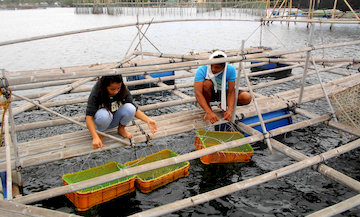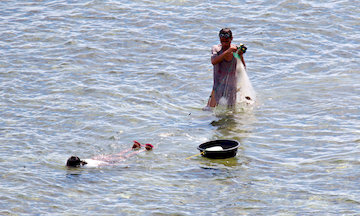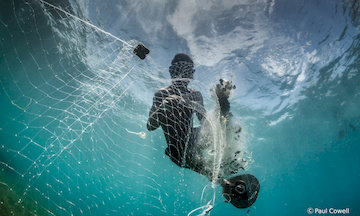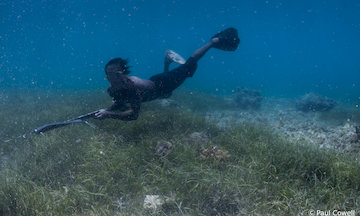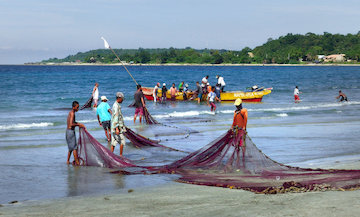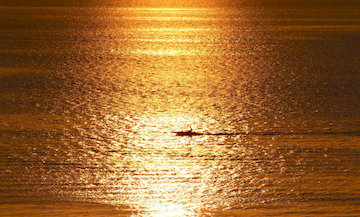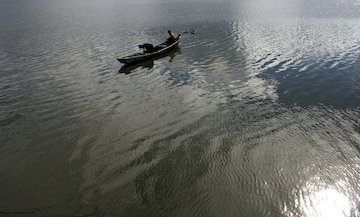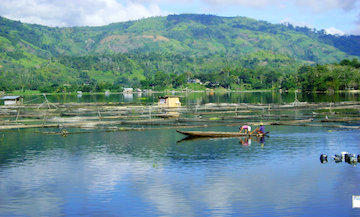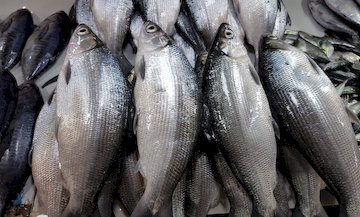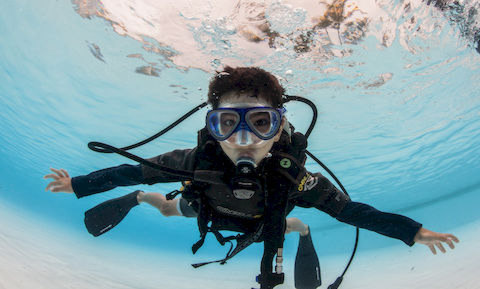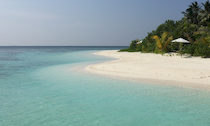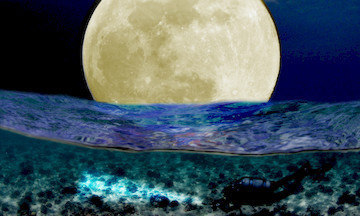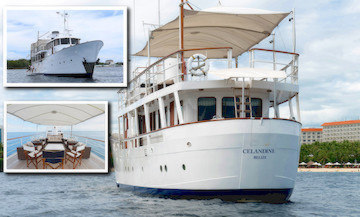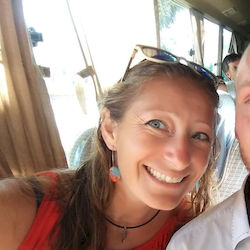Fishing in the Philippines and local fishing techniques
As a country made up of 7,641 islands (new count from 2016), fishing is a major source of livelihood for Filipinos living in coastal villages. It is one of the most vital economic activity that has fed and provided the needs of millions of Filipinos for centuries.
On this week's blog, we talk about fishing in the Philippines!
Philippine Fisheries
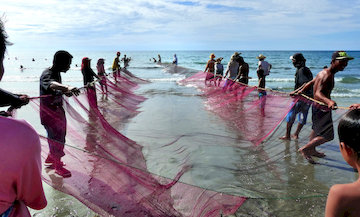 If you're a Filipino or if you have been to the Philippines, no menu is complete without seafood, especially fish. There are three types of fisheries in the Philippines, namely: inland capture fisheries, aquaculture, and marine capture fisheries.
If you're a Filipino or if you have been to the Philippines, no menu is complete without seafood, especially fish. There are three types of fisheries in the Philippines, namely: inland capture fisheries, aquaculture, and marine capture fisheries.
Inland capture fisheries involve fishing in enclosed freshwater areas like lakes, reservoirs, rivers, estuaries, and natural brackish water (mixed seawater and freshwater) fishponds.
Aquaculture refers to all fisheries that involve culturing and raising aquatic species under controlled conditions in freshwater, brackish water, and marine water areas. One example is the Oyster farm in Cambuhat River, Bohol.
Marine Capture Fisheries in the Philippines
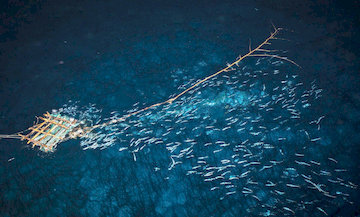 Marine capture fisheries are divided into two, namely, commercial fishing and municipal fishing.
Marine capture fisheries are divided into two, namely, commercial fishing and municipal fishing.
Commercial fishing is catching fish and seafood with the use of fishing vessels that are more than three gross tonnages (Gross tonnage is the total volume of a boat). The group of fishers uses trawls, long lines, ring nets, lift nets, and purse seines to catch large quantities of seafood for commercial profit, trade or business.
Municipal fishing is done within municipal waters (including lakes, streams, inland bodies of water, etc.) with the use of simple gears and vessels of three gross tonnes or less. Fisherfolks use motorized or unmotorized banca boats and gillnets, handlines, small ring nets, and traps.
Traditional Fishing in the Philippines
Spearfishing, as the name denotes, is catching fish in freshwater or saltwater with the use of a spear. The most common spear device is the spear gun. Spear guns are commonly used by the Badjaos (also known as Sama people or Sea Gypsies). Another type of spear is the sling spear or pole spear, in which a hand-held slingshot launches the spear.
The use of payaos is another fishing practice in the Philippines. Payaos is a Fish-Aggregating Device (FAD) used to lure fishes, especially tuna, into handlines or fishing nets. A traditional payaos is a bamboo raft constructed with a superstructure or collection device below the surface.
Payaos is effective in small-scale and large-scale fisheries. Lights are sometimes used in modern payaos, especially in commercial fishing. Bureau of Fisheries and Aquatic Resources in the Philippines has limited the use of FADs to lessen the fatality of juvenile yellowfins and bigeye tunas.
Unique Fishing Techniques in the Philippines

A unique fishing technique practiced in the Philippines (and other countries in Asia) is by slapping the water with a long bamboo. Fishermen do this technique to scare the fishes, squids, or other marine animals into their nets. This technique is useful when trying to catch the fishes swimming near the surface.
Another unique fishing technique is by the use of "Bobo" traps or fish pots. The device used for the traps is made of bamboo with a trap-like entrance and a sharp edge to keep the fish inside once it is caught. The fishermen lower the line of 10 to 14 Bobo traps on the seabed, just 10 kilometers (~6 miles) away from municipal waters, and leave it for three days.
What's amusing about this technique is that they know exactly where to find the traps without the use of poles, buoys, or a GPS system. It's all in their level of estimation. They trawl the waters with a hooked bamboo and minutes later, they raise the traps to unload catch. Then, they lower the traps again for the next harvest. The fishermen who use this method traditionally claim that they always find their line of traps no matter what.
Destructive Fishing in the Philippines
For efficiency and more catch, some Filipino fishers have depended on destructive fishing methods. The most common in the Philippines is cyanide and blast fishing (also known as dynamite fishing).
Cyanide fishing is squirting sodium cyanide into the fish's habitat or coral reef to paralyze the fish and make it easier to catch alive. This practice started in the 1960s as a way to supply the international aquarium trade. Soon, it became a method for Filipino fishers who supply live fishes for restaurants in Hongkong, Singapore, and mainland China.
Blast fishing, or "dynamite fishing", is another quick and destructive method because it kills more than just fishes. The explosives used in this method set off underwater and destroy the coral reefs, leaving nothing but rubble. It can affect the marine biodiversity in the area, from sea turtles to sharks and other marine species.
Both cyanide and dynamite fishing are illegal in the Philippines since 1932, but sadly, some fish folks still practice it today.
The Effects of Destructive Fishing Practices
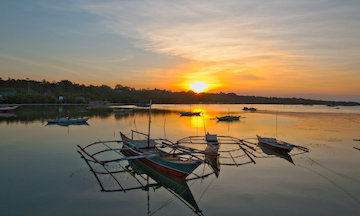 Destructive fishing practices are not only harmful to the environment, but to us as well. Using cyanide and dynamites to catch seafood are the two most common destructive fishing techniques in the Philippines, and there could be more.
Destructive fishing practices are not only harmful to the environment, but to us as well. Using cyanide and dynamites to catch seafood are the two most common destructive fishing techniques in the Philippines, and there could be more.
How does this affect us? With uncontrolled and destructive fishing practices, there will be lesser seafood to catch in the later years. Coral reefs, fishes and other aquatic animals can no longer live and spawn in a healthy environment.
The seafood that we eat could be contaminated with cyanide and other harmful chemicals. Fisheries production will deplete since more juvenile fishes are caught every day. A few fishes that survived do mature and spawn, but it will never be enough to sustain and suffice the population.
The Efforts to Save Philippine Reefs
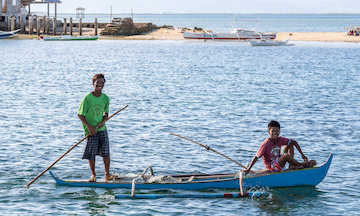 Despite the laws and policies promulgated by the government against illegal fishing activities, some Filipino fishers still practice unlawful methods.
Despite the laws and policies promulgated by the government against illegal fishing activities, some Filipino fishers still practice unlawful methods.
The practice of using dynamite and cyanide in catching fish is still rampant in the Philippines because of unregulated patrolling and checkpoints, which lead to lesser chances of getting caught. Penalties are not so heavy as well.
To save our reefs from permanent extinction, private organizations have started working with the local government and communities to stop illegal fishing and introduce a better and safer livelihood instead- like ecotourism.
Local Effort by Cebuano and Boholano Divers
One local effort worth recognizing is by the Sea Knights, a faith-based group in Cebu, and local Boholano divers. They sank a four meter (14-foot) statue of the Virgin Mary in the Danajon Bank, located in the Camotes Sea.
Danajon Bank has one of the world's rarest double-barrier reef, but the corals have suffered enormous damage and loss from blast fishing. By sinking Catholic statues, they hope to discourage God-fearing fishers from practicing illegal fishing methods in the area again.
Fishing in the Philippines Researches and References
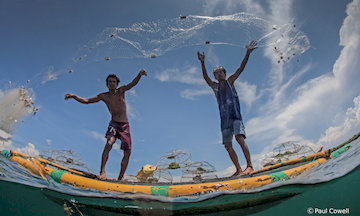 Images and Photos we use are from:
Images and Photos we use are from:
- Gerard Castiel
- Paul Cowell
- Patrice Laborda
- Bernard Spragg
- Green Peace (the fishing aggregating device)
If you want to know more about fishing in the Philippine, take a look at some of our references below.
- Commercial fishing
- Filipino fishing techniques
- Filipino fishing techniques and gears*
- Payaos
- Fish Aggregating Device (FAD)
- Cyanide fishing
- Cyanide a deadly way to catch fish
- Blast fishing
- Dynamite and Poisonous fishing
- Philippines Dynamite fishing
- Illegal Methods
- Local effort in illegal fishing
- Fisheries profile
- Fishing in the Philippines
- Country Stat
[*] The original link of the PDF is: [ https://repository.seafdec.org.ph/handle/10862/1098 ], but their server is alway timed out, unavailable or too busy, we will host it until their server will become accessible, in a more reasonable way, for you to EASILY check our reference, all rights of that PDF are to repository.seafdec.org.ph
Speaking about fishing, I know a good place for game fish in philippines or sport fishing...
Last, but not Least
If you would like to receive interesting content like this in your email Inbox, subscribe to our newsletter.
In addition to our monthly newsletter, we will send you our weekly e-Bulletin with one fascinating topic, like today's article above. There will be no advertising nor sales pitch.
As always we want to thank Youtube and Wikipedia commons for some amazing images and/or videos on this page!
Thanks for reading, and if you wish, see you next week!
The Research and Media Team at Scotty's.
Disclaimer:
The views, ideas, and opinions expressed by the writers of Scotty's Media team do not necessarily reflect or represent the views, ideas, and opinions of the company, Scotty's Action Sports Network, Inc.
More Pictures About Fishing in the Philippines
